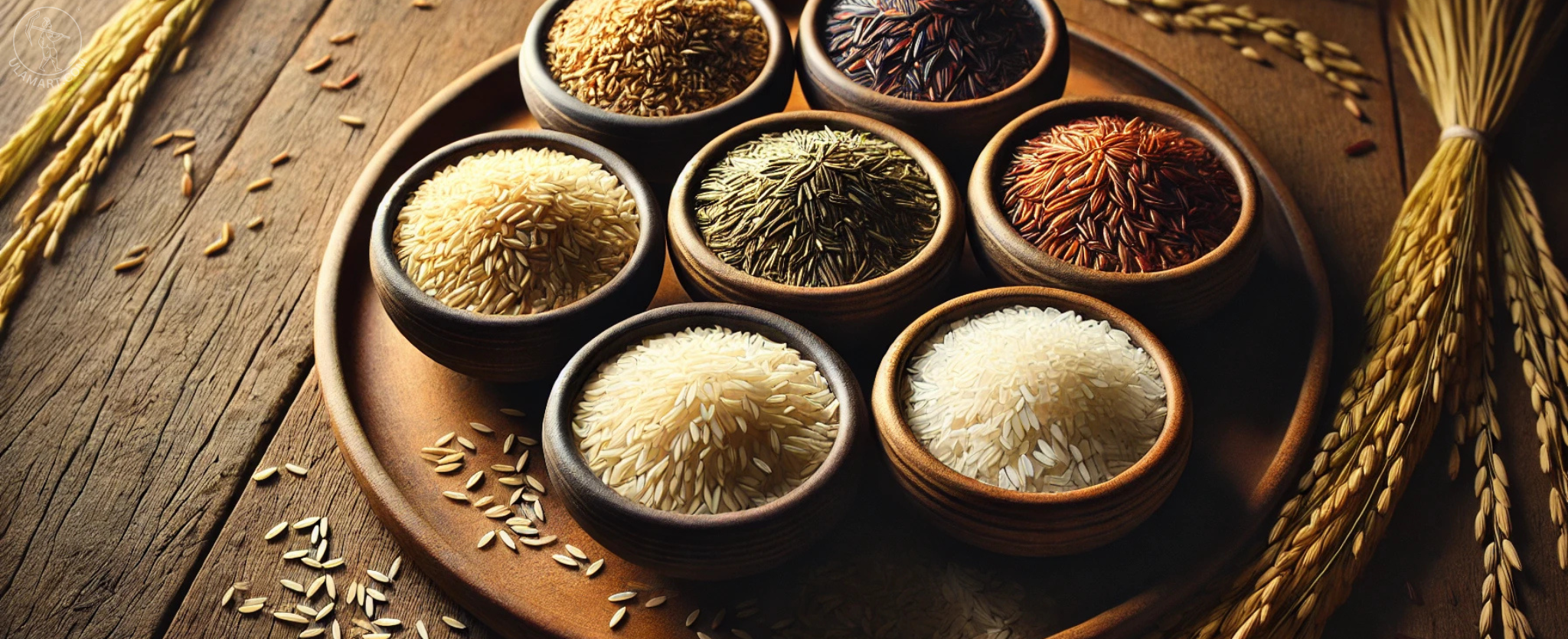In the rich tapestry of Indian culinary traditions, rice holds a cherished place as a staple that graces our tables in myriad forms. From aromatic biryanis to humble khichdis, the choice of rice variety can significantly impact the taste, texture, and nutritional value of our meals.
In this comprehensive guide, we delve into the heart of Indian culinary heritage to help you navigate the world of rice varieties and select the perfect grains for your healthy meals.
1. Understanding the Diversity of Rice
2. Exploring the Nutritional Value and Health Benefits of Diverse Rice Varieties
3. A Treasure Trove of Organic Tradition
1. Understanding the Diversity of Rice:
India boasts an astonishing diversity of rice varieties, each with its unique characteristics and culinary applications.
From the fragrant Basmati to the nutty brown rice and the hearty red rice, the choices are abundant. Before we delve into the selection process, let’s explore some of these varieties and their qualities.
Rice | IMAGE | Rice Description | |
The Fragrant Jewel: Derived from the Sanskrit word 'vasmati,' which means 'fragrant,' Basmati rice is renowned for its delicate aroma and long grains. It is preferred for its use in various dishes and special occasions. | |||
| Earthy and Wholesome: This red rice variety offers a robust, earthy flavor and chewy texture. Perfect for traditional dishes like curd rice or dahi bhat, red rice adds a rustic touch to your meals. | ||
The Fragrance of Tradition: Thooyamalli rice, known for its distinct aroma, brings an essence of tradition to your meals. Often used in traditional South Indian dishes, this rice variety carries a unique fragrance that elevates your dining experience. | |||
Ancient Elegance: With its striking black color, Karuppu Kavuni rice is a rare gem known for its rich history. Traditionally cultivated in Tamil Nadu, this heirloom rice variety adds a touch of elegance to your culinary creations. | |||
A Heritage Treasure: Mappilai Samba rice, a heritage treasure from Tamil Nadu, offers a delightful blend of taste and nutrition. Its short grains are perfect for creating traditional dishes that have been savored for generations. | |||
A Southern Staple: Ponni rice, a popular choice in South India, is loved for its versatility and ability to complement a wide range of dishes. Whether it's sambars, rasams, or biryanis, Ponni rice is a dependable staple. | |||
Tiny Grains, Immense Flavor: Seeraga Samba rice, characterized by its small grains, is a powerhouse of flavor. Often used in Biryani and Pulao recipes, this variety ensures that every bite is infused with aromatic delight. | |||
The Essence of Festivity: Pongal, a beloved South Indian dish, owes its delectable taste to Pachai Arisi. This rice variety is integral to festive celebrations and carries the essence of togetherness. |
2. Exploring the Nutritional Value and Health Benefits of Diverse Rice Varieties :
Each rice variety offers unique health benefits that contribute to your overall well-being. Let’s explore the distinctive advantages they bring to your table:
- Basmati Rice: Low glycemic index aids in better blood sugar control. Rich in essential nutrients like vitamins and minerals.
- Red Rice: Abundant in antioxidants that help protect cells from damage. Provides dietary fiber for a healthy gut.
- Thooymalli Rice: Distinct aroma enhances appetite and sensory experience. Contains essential amino acids for protein synthesis.
- Karuppu Kavuni Rice: Natural source of anthocyanins, potent antioxidants. May have potential health benefits due to its unique pigment.
- Mappilai Samba Rice: Low in calories and high in nutrients. Provides sustained energy release for active lifestyles.
- Ponni Rice: Easily digestible and suitable for various dishes. Contains essential nutrients for overall health.
- Seeraga Samba Rice: Rich in selenium, a mineral with antioxidant properties. May contribute to immune system support.
- Pachai Arisi or Pongal Rice: Light and easily digestible. Used traditionally in cleansing and detoxifying rituals.
3. A Treasure Trove of Organic Tradition:
Ulamart We take delight in providing you with a wide selection of more than 30 traditional rice varieties at Ulamart, all of which are farmed organically to assure the greatest quality and nutritional value. The variety of rice grains we offer reflects our dedication to maintaining the diversity of Indian culinary history.
Decoding Tradition: How to Choose the Right Rice:
When selecting the right rice variety for your healthy Indian meals, consider the following factors:

Meal Type: Different rice varieties complement specific dishes. For example:
- Biryanis and Pulaos: Fragrant rice varieties like Basmati and Seeraga Samba rice are preferred for these dishes due to their aromatic nature and long grains. These rice types enhance the overall flavor and presentation of the dish.
- Everyday Meals: Shorter-grain rice varieties are suitable for everyday meals. They work well for dishes where you want individual grains to remain separate and not stick together.
Texture Matters: The texture of rice can significantly impact the dining experience:
- Separate and Fluffy Grains: If you desire rice grains that are separate, distinct, and fluffy, Basmati rice is an excellent choice. It cooks up light and airy, making it ideal for dishes where each grain should be discernible.
- Creamy Consistency: For dishes that require a creamier consistency, consider rice varieties like Thooyamalli or Karuppu Kavuni. These rice types tend to absorb more moisture and develop a smoother, cohesive texture.
Nutritional Value:
Unpolished rice varieties retain more of their bran and germ layers compared to polished (white) rice. These layers contain essential nutrients like fiber, vitamins, and minerals. Choosing unpolished rice varieties can provide added nutritional benefits to your meals.
Flavor Profile: The taste of rice can influence the overall flavor of your dish:
- Fragrant Varieties: Fragrant rice varieties, like Kalanamak and Thooyamalli, have a delicate aroma that can infuse the dish with their fragrance, enhancing the overall flavor.
- Earthy Tastes: Some rice types offer a more earthy or nutty taste, which can complement certain dishes. For instance, red rice provides a robust, earthy flavor.
Culinary Technique: Different culinary techniques require specific rice characteristics:
- Flavor Absorption: Some dishes, like curries, stews, or tomato rice, benefit from rice that can absorb flavors well. Varieties like Thooyamalli or Mappilai Samba from Tamil Nadu are known for this property.
- Grain Separation: Some recipes, such as Pongal, Idli, Dosa, various sweets, and pulao, demand rice grains that remain separate and don’t clump together. In such cases, rice varieties like Basmati, Seeraga Samba, Ponni, or Sona Masuri from Tamil Nadu can be excellent choices.
Embracing Tradition: Recipes for Wholesome Delights:

- Biryani with Basmati Bliss: Experience the magic of Basmati rice in a fragrant vegetable biryani bursting with colors and flavors.
- Coconut Milk Rice with Karuppu Kavuni: Discover the allure of Karuppu Kavuni rice in a creamy coconut milk-infused dish. This velvety creation pays homage to ancient traditions while tantalizing your taste buds with its unique flavor.
- Mappilai Samba Sambar Sadam: Delve into the world of Mappilai Samba rice with this delectable sambar rice recipe. The short grains of Mappilai Samba perfectly absorb the rich flavors of the sambar, creating a harmonious blend of taste and heritage.
- Thooymalli Curd Rice: Experience comfort on a plate with Thooymalli curd rice. The aroma of Thooymalli rice combines with the tangy goodness of curd, creating a dish that soothes the soul and satisfies your cravings.
- Seeraga Samba Biryani: Elevate your biryani game with the aromatic Seeraga Samba rice. Each tiny grain carries the essence of spices, creating a symphony of flavors that’s bound to impress your guests.
- Pachai Arisi Pongal: Embrace the festive spirit with a hearty serving of Pachai Arisi Pongal. This traditional dish, made with freshly harvested rice, celebrates togetherness and is a delightful addition to your celebratory feasts.
- Bamboo Rice Kheer: Indulge in the rich flavors of Bamboo Rice Kheer, a dessert that showcases the unique taste of bamboo rice. Creamy and comforting, this kheer is a delightful finale to any meal.
- Kala Namak Rice Salad: Elevate your salad game with the addition of Kala Namak rice. Its nutty flavor and distinctive color add a touch of elegance to your greens, making healthy eating a truly enjoyable experience.
4. Conclusion:
In the intricate mosaic of Indian culinary customs, the choice of rice is an art that harmonizes flavor, tradition, and nutrition. Armed with the knowledge of diverse rice varieties, their attributes, and the factors influencing selection, you can now embark on a culinary journey that celebrates health and heritage. So, whether you’re crafting a biryani fit for royalty or a humble bowl of comfort, remember that the right rice variety can make all the difference in creating an unforgettable meal that nourishes both body and soul.















